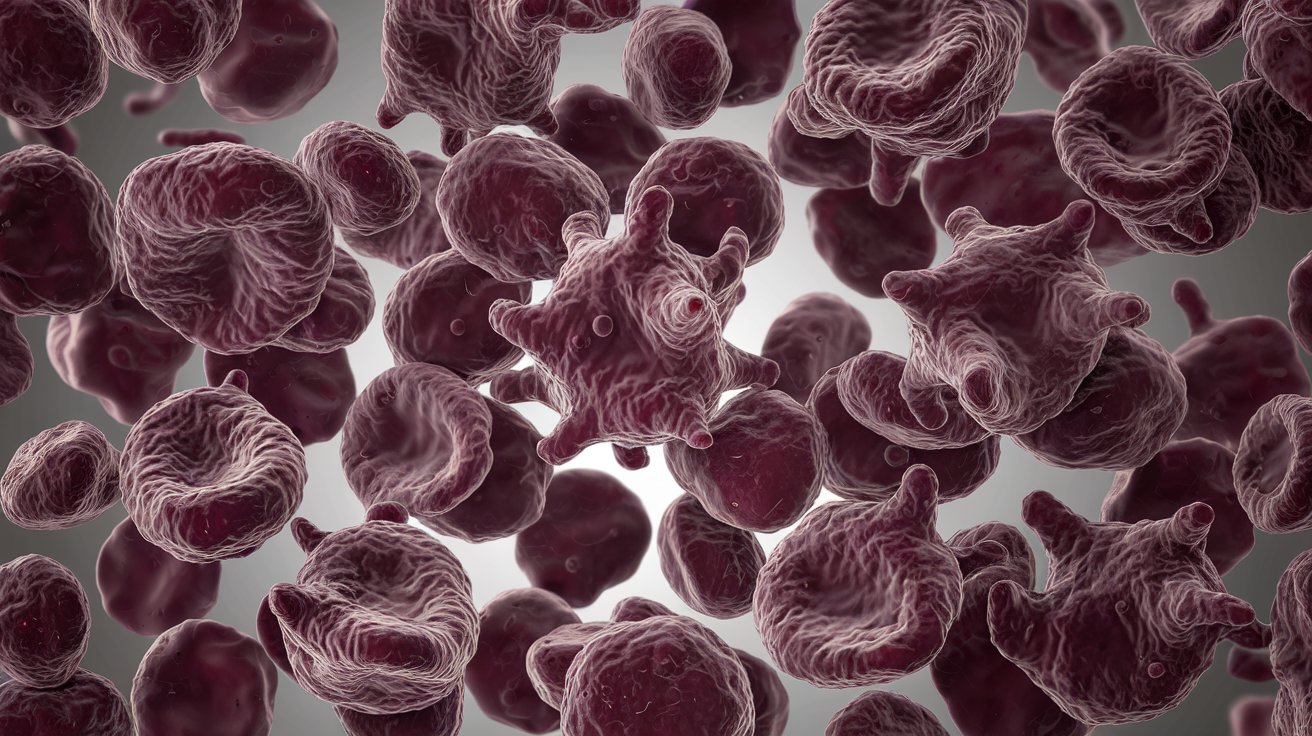
Xerocytosis is a rare genetic disorder affecting red blood cells, causing them to become dehydrated and misshapen. This condition can lead to various health issues, including anemia, fatigue, and an enlarged spleen. Xerocytosis is often inherited in an autosomal dominant manner, meaning only one copy of the mutated gene is needed to develop the disorder. Symptoms can vary widely, from mild to severe, and may appear at any age. Diagnosing xerocytosis typically involves blood tests, genetic testing, and sometimes a bone marrow biopsy. Treatment focuses on managing symptoms and may include folic acid supplements, blood transfusions, or even spleen removal in severe cases. Understanding xerocytosis is crucial for those affected and their families, as early diagnosis and proper management can significantly improve quality of life.
Key Takeaways:
- Xerocytosis is a rare genetic disorder that dehydrates red blood cells, causing symptoms like anemia and fatigue. Genetic testing and supportive care are crucial for managing this condition.
- Ongoing research and clinical trials offer hope for better understanding and treating xerocytosis. Patients can benefit from regular medical check-ups, hydration, and balanced diet to manage symptoms effectively.
Understanding Xerocytosis
Xerocytosis is a rare genetic disorder affecting red blood cells. It causes them to become dehydrated, leading to various health issues. Here are some fascinating facts about this condition.
-
Xerocytosis is a type of hereditary stomatocytosis. This means it is passed down through families and affects the shape of red blood cells.
-
The name 'xerocytosis' comes from the Greek word 'xero,' meaning dry. This refers to the dehydrated state of the red blood cells in affected individuals.
-
Xerocytosis is caused by mutations in the PIEZO1 gene. This gene plays a crucial role in the mechanical properties of red blood cells.
-
Symptoms of xerocytosis can vary widely. Some people may have mild anemia, while others experience severe fatigue, jaundice, or an enlarged spleen.
-
Xerocytosis is often diagnosed through blood tests. These tests can reveal the characteristic dehydrated red blood cells and other abnormalities.
Genetic Aspects of Xerocytosis
The genetic basis of xerocytosis is complex, involving specific mutations that affect red blood cell function.
-
PIEZO1 gene mutations are the primary cause of xerocytosis. These mutations alter the way red blood cells respond to mechanical stress.
-
Xerocytosis is inherited in an autosomal dominant pattern. This means only one copy of the mutated gene is needed to cause the disorder.
-
Genetic testing can confirm a diagnosis of xerocytosis. This involves analyzing the PIEZO1 gene for specific mutations.
-
Family history plays a significant role in diagnosing xerocytosis. If a parent has the condition, there is a 50% chance of passing it to their children.
-
Carrier testing is available for families with a history of xerocytosis. This can help identify individuals who may pass the gene to their offspring.
Symptoms and Complications
Xerocytosis can lead to various symptoms and complications, affecting overall health and quality of life.
-
Anemia is a common symptom of xerocytosis. This occurs because the dehydrated red blood cells are less efficient at carrying oxygen.
-
Jaundice can occur in individuals with xerocytosis. This yellowing of the skin and eyes is due to the breakdown of red blood cells.
-
Splenomegaly, or an enlarged spleen, is another possible complication. The spleen works harder to filter the abnormal red blood cells, causing it to enlarge.
-
Fatigue is a frequent complaint among those with xerocytosis. The reduced oxygen-carrying capacity of the blood leads to persistent tiredness.
-
Gallstones can develop in people with xerocytosis. The increased breakdown of red blood cells leads to higher levels of bilirubin, which can form stones.
Diagnosis and Treatment
Diagnosing and managing xerocytosis involves various medical approaches to ensure proper care.
-
Blood smear tests are essential for diagnosing xerocytosis. These tests can show the characteristic dehydrated red blood cells.
-
Osmotic fragility tests help assess red blood cell stability. This test measures how easily red blood cells burst when placed in different solutions.
-
Genetic testing confirms the diagnosis of xerocytosis. Identifying PIEZO1 gene mutations is crucial for an accurate diagnosis.
-
Treatment focuses on managing symptoms rather than curing the condition. There is no specific cure for xerocytosis, so care is supportive.
-
Folic acid supplements can help manage anemia. Folic acid supports red blood cell production, which can alleviate some symptoms.
Living with Xerocytosis
Living with xerocytosis requires ongoing medical care and lifestyle adjustments to manage symptoms effectively.
-
Regular medical check-ups are vital for managing xerocytosis. Monitoring blood counts and organ function helps prevent complications.
-
Staying hydrated is crucial for individuals with xerocytosis. Proper hydration can help maintain red blood cell function.
-
Avoiding high altitudes can prevent complications. Reduced oxygen levels at high altitudes can worsen symptoms of anemia.
-
Maintaining a balanced diet supports overall health. Nutrient-rich foods can help manage symptoms and improve quality of life.
-
Physical activity should be moderated. While exercise is beneficial, overexertion can exacerbate fatigue and other symptoms.
Research and Future Directions
Ongoing research aims to better understand xerocytosis and develop new treatments.
-
Researchers are studying the PIEZO1 gene in detail. Understanding its role in red blood cell function could lead to new therapies.
-
Clinical trials are exploring potential treatments. New drugs and therapies are being tested to improve symptoms and quality of life.
-
Gene therapy holds promise for xerocytosis. Correcting the genetic mutation could potentially cure the condition in the future.
-
Patient registries help track the condition's progression. Collecting data from individuals with xerocytosis aids research and treatment development.
-
Support groups provide valuable resources. Connecting with others who have xerocytosis can offer emotional support and practical advice.
Interesting Facts about Xerocytosis
Here are some additional intriguing facts about xerocytosis that highlight its unique aspects.
-
Xerocytosis is considered a rare disease. It affects fewer than 200,000 people in the United States.
-
The condition was first described in the 1960s. Early research identified the characteristic dehydrated red blood cells.
-
Xerocytosis can be mistaken for other blood disorders. Conditions like hereditary spherocytosis share similar symptoms, making diagnosis challenging.
-
The severity of xerocytosis can vary even within the same family. Some members may have mild symptoms, while others experience severe complications.
-
Xerocytosis can affect people of all ages. Symptoms can appear in childhood or later in life, depending on the mutation's impact.
-
The condition is more common in certain populations. Some ethnic groups have a higher prevalence of xerocytosis due to specific genetic factors.
-
Xerocytosis can complicate pregnancy. Pregnant women with the condition require careful monitoring to manage anemia and other risks.
-
Bone marrow transplants are not typically used for xerocytosis. Unlike some other blood disorders, this treatment is not effective for xerocytosis.
-
Xerocytosis research is ongoing worldwide. Scientists in various countries are working to better understand and treat the condition.
-
Awareness of xerocytosis is growing. Increased knowledge and research are helping improve diagnosis and management for those affected.
Final Thoughts on Xerocytosis
Xerocytosis, a rare genetic disorder, affects red blood cells, causing them to become dehydrated and misshapen. This condition can lead to various symptoms, including anemia, fatigue, and jaundice. Understanding the genetic basis of xerocytosis is crucial for accurate diagnosis and effective treatment. Genetic testing can identify mutations in the PIEZO1 gene, which is often responsible for this disorder. While there is no cure, managing symptoms through regular medical care and monitoring can improve the quality of life for those affected. Staying informed about the latest research and advancements in treatment options is essential for patients and their families. By raising awareness and supporting ongoing research, we can hope for better outcomes and potentially new therapies in the future. Remember, knowledge is power, and staying educated about xerocytosis can make a significant difference.
Frequently Asked Questions
Was this page helpful?
Our commitment to delivering trustworthy and engaging content is at the heart of what we do. Each fact on our site is contributed by real users like you, bringing a wealth of diverse insights and information. To ensure the highest standards of accuracy and reliability, our dedicated editors meticulously review each submission. This process guarantees that the facts we share are not only fascinating but also credible. Trust in our commitment to quality and authenticity as you explore and learn with us.


